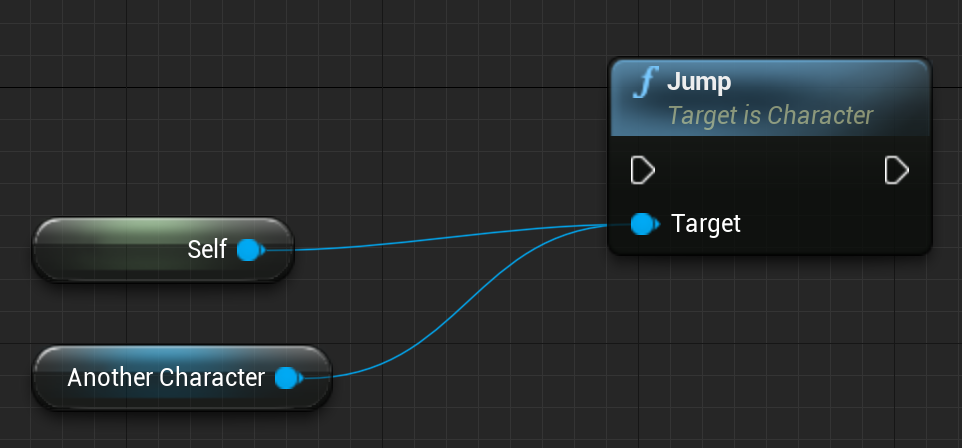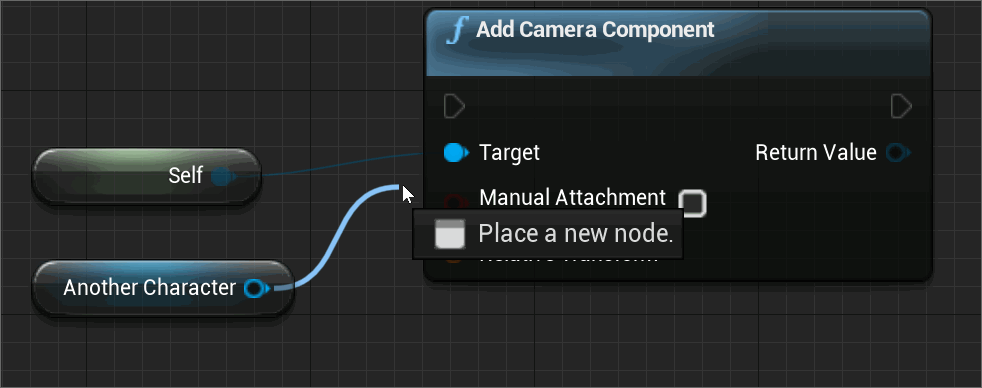Description


Cause
查看两个UFUNCTION的specifier
// Allow multple links to Target
UFUNCTION(BlueprintCallable, Category=Character)
virtual void Jump();
// Unallow
UFUNCTION(BlueprintCallable, meta=(ScriptNoExport, BlueprintInternalUseOnly = "true", DefaultToSelf="ComponentTemplateContext", InternalUseParam="ComponentTemplateContext"))
class UActorComponent* AddComponent(FName TemplateName, bool bManualAttachment, const FTransform& RelativeTransform, const UObject* ComponentTemplateContext);
看上去没有什么和Pin直接有关系的,只不过蓝图中是AddCameraComponent,而源代码则指向了一个通用的AddComponent,也就是说,蓝图中的这个函数结点是根据通用函数生成出来的,并没有实际的函数对应。
于是顺着结点生成的相关代码找去,通过Debugger捕捉Link和Unlink的行为,终于发现和下面这个函数有关,大家重点关注bMultipleSelfException的赋值:
const FPinConnectionResponse UEdGraphSchema_K2::DetermineConnectionResponseOfCompatibleTypedPins(const UEdGraphPin* PinA, const UEdGraphPin* PinB, const UEdGraphPin* InputPin, const UEdGraphPin* OutputPin) const
{
// Now check to see if there are already connections and this is an 'exclusive' connection
const bool bBreakExistingDueToExecOutput = IsExecPin(*OutputPin) && (OutputPin->LinkedTo.Num() > 0);
const bool bBreakExistingDueToDataInput = !IsExecPin(*InputPin) && (InputPin->LinkedTo.Num() > 0);
bool bMultipleSelfException = false;
const UK2Node* OwningNode = Cast<UK2Node>(InputPin->GetOwningNode());
if (bBreakExistingDueToDataInput &&
IsSelfPin(*InputPin) &&
OwningNode &&
OwningNode->AllowMultipleSelfs(false) &&
!InputPin->PinType.IsContainer() &&
!OutputPin->PinType.IsContainer() )
{
//check if the node wont be expanded as foreach call, if there is a link to an array
bool bAnyContainerInput = false;
for(int InputLinkIndex = 0; InputLinkIndex < InputPin->LinkedTo.Num(); InputLinkIndex++)
{
if(const UEdGraphPin* Pin = InputPin->LinkedTo[InputLinkIndex])
{
if(Pin->PinType.IsContainer())
{
bAnyContainerInput = true;
break;
}
}
}
bMultipleSelfException = !bAnyContainerInput;
}
if (bBreakExistingDueToExecOutput)
{
const ECanCreateConnectionResponse ReplyBreakOutputs = (PinA == OutputPin) ? CONNECT_RESPONSE_BREAK_OTHERS_A : CONNECT_RESPONSE_BREAK_OTHERS_B;
return FPinConnectionResponse(ReplyBreakOutputs, TEXT("Replace existing output connections"));
}
else if (bBreakExistingDueToDataInput && !bMultipleSelfException)
{
const ECanCreateConnectionResponse ReplyBreakInputs = (PinA == InputPin) ? CONNECT_RESPONSE_BREAK_OTHERS_A : CONNECT_RESPONSE_BREAK_OTHERS_B;
return FPinConnectionResponse(ReplyBreakInputs, TEXT("Replace existing input connections"));
}
else
{
return FPinConnectionResponse(CONNECT_RESPONSE_MAKE, TEXT(""));
}
}
看来只有Target(也就是CPP函数的this)的Pin可以连接,并且使用的函数结点其AllowMultipleSelfs()也要返回True,至于其他条件代码写的很明白就不说了。
不同的结点类型,允许连接多个对象的条件不同,譬如UK2Node_CallFunction这个类型就会以函数是否有返回值作为标准,如下:
bool UK2Node_CallFunction::AllowMultipleSelfs(bool bInputAsArray) const
{
if (UFunction* Function = GetTargetFunction())
{
return CanFunctionSupportMultipleTargets(Function);
}
return Super::AllowMultipleSelfs(bInputAsArray);
}
bool UK2Node_CallFunction::CanFunctionSupportMultipleTargets(UFunction const* Function)
{
bool const bIsImpure = !Function->HasAnyFunctionFlags(FUNC_BlueprintPure);
bool const bIsLatent = Function->HasMetaData(FBlueprintMetadata::MD_Latent);
bool const bHasReturnParam = (Function->GetReturnProperty() != nullptr);
return !bHasReturnParam && bIsImpure && !bIsLatent;
}